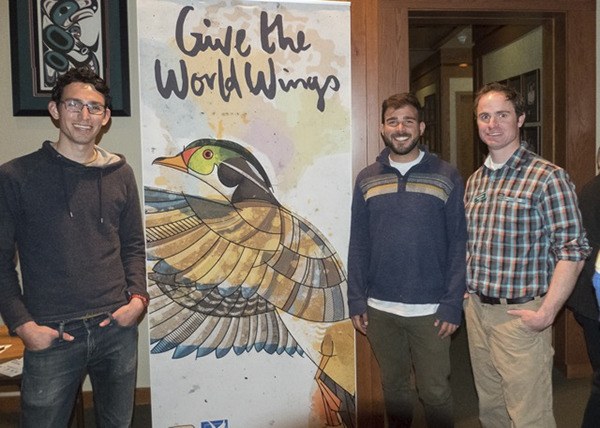Two interns with Environment for the Americas, the “BirdTrippers,” also known as the “Pacific Flyway Ambassadors,” are attempting to do what millions of birds do every year — travel more than 3,500 miles from Southern California to Alaska. The journey follows a portion of a major north-south bird migration route, the Pacific Flyway, spanning between Arctic tundra and South American wetlands.
“The goal is to reach out to as many people as possible, particularly those that aren’t as engaged with the environment as a generation and as a community in order to create a larger group of people that value the environment and the birds’ habitat because at the end of the day you can’t vote in favor of things of or act on things that you don’t know exist,” BirdTripper Christian McWilliams said.
Mimicking the birds’ migration, McWilliams and fellow BirdTripper Jean Rodriguez-Ramos are stopping in towns, cities, on public lands and at other wildlife “hot spots” as they bird and road trip north, which began early March.
Recognizing the Olympic Peninsula as an area long sought out by birders, on April 16 the BirdTrippers visited Sequim and attended part of the Olympic BirdFest organized by the Olympic Peninsula Audubon Society.
As the BirdTrippers bring awareness, connect the communities like Sequim encountered by migrating birds and learn about the challenges often faced by the birds, the three-month journey celebrates 100 years of migratory bird conservation.
The first Migratory Bird Treaty aimed to protect and coordinate conservation and management of migratory bird populations was signed in 1916 between the United States and Canada. Since, three similar treaties have been signed and together form the foundation for the international efforts to conserve birds that know no borders.
Although the BirdTrippers share educational backgrounds in conservation and science, when it comes to birding they consider themselves novices. However, as novices McWilliams and Rodriguez-Ramos are able to convey their enthusiastic sense of discovery and the information they’re learning with a broad spectrum of people and are doing so in both English and Spanish.
“We’re taking a different approach to reach out to millennials and younger people about our experience,” Rodriguez-Ramos said.
Utilizing Instagram, Twitter, Facebook, a website with an interactive map and blog, “we’re doing the best we can to reach as many people as we can,” he said.
Already, in the midst of their trip the BirdTrippers can see the vast community connections created by the migrating birds and how what one community does can have lasting impacts across the Pacific Flyway.
“Loss of habitat mostly because of human activity and introduced species is something we’ve been learning a lot about … but, it’s impressive the number agencies working together to restore the habitat and make sure the specific species have a place to nest,” Rodriguez-Ramos said.
Another common challenge the BirdTrippers have noticed being dealt with in communities along the Pacific Flyway is the ability to balance multiple uses so both humans and the birds that rely on specific habitat can coexist.
Effective, far-reaching “communication” also is emerging as being important when trying to conserve and protect migratory bird populations, McWilliams said. “It’s interesting to see the different conservation efforts are working in one place, but needing to be duplicated in neighboring communities.”
Even through it’s not work being done in the field, Rodriguez-Ramos noted the importance of educational outreach and advocacy because it “supplements” the field work.
A core and vital workforce aiding the overall international effort to maintain the health of the Pacific Flyway and its users that the BirdTrippers have encountered are volunteers.
“Whether it’s the casual volunteer, citizen scientists, federal or state organizations, nonprofits, scientists or schools — these birds rely on all these people and their partnerships,” McWilliams said.
Upon completion of the migratory journey the BirdTrippers will create a final report aimed to inform agencies like U.S. Fish & Wildlife Service and others that collaborate to manage and conserve migrating bird populations.
To follow the BirdTrippers and learn about their experiences along the Pacific Flyway, visit birdtrippers.com.
BirdTrippers supporting partners include Environment for the Americas, U.S. Fish & Wildlife Service, Environment and Climate Change Canada, National Audubon Society, Bureau of Land Management, National Park Service and the U.S. Forest Service.


